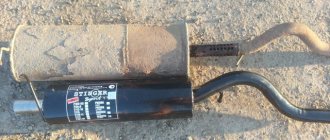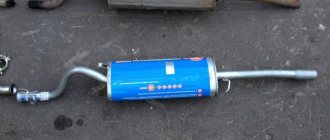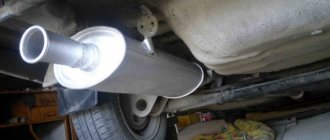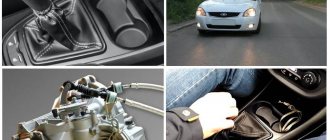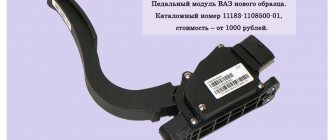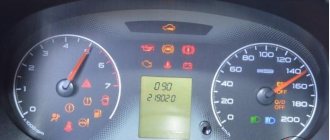Exhaust system
Exhaust system: 1, 3 — bracket for the suspension cushion of the additional muffler;
2 — additional muffler; 4 — vibration compensation bellows; 5 - gasket; 6 — catalytic converter with exhaust catalyst (muffler inlet pipe); 7 — ball joint clamp; 8 — ball joint gasket; 9 - main extinguisher Exhaust gases are removed from the engine through the exhaust pipe of the muffler with a neutralizer, an additional muffler and a main muffler. A sealing gasket is installed between the flanges of the exhaust pipe and the additional muffler. There is a vibration compensator on the additional muffler pipe. The pipes of the main and additional mufflers are connected to each other by flared ends through an intermediate ring using a clamp. The gas exhaust system is attached to the car body using muffler suspension cushions. The diameter of the exhaust system pipes is from 40 to 46 mm.
A catalytic converter is installed in the exhaust system. When exhaust gases pass through the converter, toxic carbon monoxide (CO) is converted into low-toxic carbon dioxide (CO:), nitrogen oxides are reduced to harmless nitrogen, and the content of toxic hydrocarbon compounds (CH) is greatly reduced. As a result, the degree of gas purification in a working neutralizer reaches 90-95%.
To protect the base of the body from heating by the exhaust system elements, thermal screens are installed above the neutralizer, main and additional mufflers, and on the fuel tank. In addition to them, an additional heat-insulating shield is installed in the engine compartment to protect the steering mechanism from overheating.
The exhaust system does not require special maintenance. It is enough to periodically check the reliability of tightening of threaded connections, the integrity of the suspension cushions, and the tightness of the exhaust system. Mufflers and catalytic collector are non-separable units; if they fail, they are replaced as an assembly.
Figures 7 and 8 — Checking the tightness of the exhaust system
The passage of gases in the connections of the exhaust gas system is not allowed.
Video
Source of the article: https://lada-vesta.com.ru/html/d013.html
Obvious advantages of our store
1. Free delivery of orders over 15,000 rubles
2. Cumulative discounts up to 10%
3. Easy to order, easy to pay, easy to pick up
4. We do not limit you in choosing a transport company
5. We transfer fees With us you can pay only for the selected product
Hi all! Finally changed my entire exhaust system. The choice was between stinger and stt. I asked many people which one was better and almost everyone chose stt. The stt has a more bass sound than the stinger (resonant).
After installation I encountered a problem. When you shift at high speeds, the manifold hits the stabilizer. Quite an unpleasant knock. I asked local craftsmen what could be done about it. There weren’t many options, either heat the pipe and bend it at the place where the knocking occurs, or wait until new additional mounts for the engine come out. The master who advised me to wait for the pillows had already installed custom pillows to check (he said there was no knocking). Accordingly, my choice fell on the second option
We also installed the firmware, cleaned the injectors and increased the sensitivity of the pedal. Next week I will install the shafts and a new receiver.
Let's figure out what the Lada Vesta exhaust system consists of
The car exhaust system of the Lada Vesta is similar to other models produced by AvtoVAZ. In many ways, the exhaust gas removal system meets modern requirements. It is made of high-quality, durable materials. However, there are shortcomings. Owners of Lada Vesta note the appearance of extraneous sounds when driving in the area of the exhaust system. Grinding, rattling, and whistling noises appear at high speeds when driving at 3000 rpm. The sedan, SV and cross versions of the Lada Vesta have the same exhaust system.
The service life of other system components depends on the functionality of the exhaust gas removal system: the engine, the acceleration dynamics of the car. If the components of the exhaust structure malfunction, a loud sound of the motor running occurs and vibration is felt. The volume of fuel consumed increases and the engine overheats. The sounds can come from the corrugation and resonator, or from the muffler.
Read the article to the end and you will find out: what the exhaust system consists of, the article numbers of its parts, a few words about nozzles and non-standard mufflers for the Lada Vesta car. Also how long does the warranty last and the price of all this.
Product range
One of the simple options for increasing engine power is tuning the exhaust system of Vesta and another model. To purchase reliable spare parts for the exhaust system of Lada Vesta, Granta, X Ray cars, contact Vesta Shop. We offer a wide range of products, including:
- replacing the resonator;
- elastic corrugations for mufflers;
- exhaust pipes;
- flanges;
- holders and more.
Products intended for Lada Vesta and X Rey are regularly updated, and therefore you can always find spare parts suitable for your exhaust system.
The use of new elements will increase engine power by 7% without noticeable fuel consumption. The products are resistant to high loads and can be easily installed because they have the required dimensions.
What does the exhaust system consist of - part numbers
The exhaust system of a Lada Vesta car is a structure that consists of several components. It is located at the bottom of the rear of the car. Each component has its own article number. If you need to order spare parts for replacement, you must indicate the article number and use it to find the required part.
| Part name | vendor code |
| An exhaust manifold | — |
| Sealant | 2110/1203021 |
| Neutralizer | 1120301000 |
| Vibration Elimination Clutch | 76558 |
| Corrugation | 265/309 |
| Main muffler | 8450030760 |
| Suspension cushions | 8450006417 |
| Pipe | 45/2000 |
| Metal fixing ring | 2170/1203073 |
The article number for analog spare parts may change.
The outlet structure is designed to remove waste products from the engine. The exhaust gases are supplied through a pipe using an additional muffler to the main muffler. A seal is installed at the junction of the pipe into which the waste material enters and moves into the additional muffler. A neutralizer is installed on the corrugation tube. Both mufflers are connected by a metal retaining ring. The entire structure is attached to the surface of the body using special cushions.
CBD muffler made of stainless steel Sports Style (pipe 51 mm) for Lada Vesta
CBD muffler made of stainless steel Sports Style (pipe 51 mm) for Lada Vesta
Material: Steel DX52/DX53 with stainless aluminum-silicon coating AS120
Muffler can size: 0.45*0.18*0.11 m
Main muffler made of stainless steel for Lada Vesta car. Suitable for all Lada Vesta models, except Vesta Sport and Vesta Cross (with modifications)
This muffler is a high-quality analogue from the manufacturer CBD of the original muffler 8450030760, which is also in our assortment.
The muffler itself is the main working part. It is a hermetically sealed (from the external environment) metal chamber with a volume of several liters (the larger the volume, the more effective), inside of which there are numerous partitions with holes, forming chambers arranged in a checkerboard pattern. When gases pass through such a labyrinth, flow pressure pulsations (arising as a result of engine operation) are absorbed and sound waves are dissipated on the developed internal surface with their energy converted into heat.
The sound is significantly louder than the standard exhaust system - pay attention to this when choosing an exhaust system.
The distinctive feature of this muffler is that the muffler has a pipe with a diameter of 51 mm (oversized). Can only be installed together with the resonator CBD220.001
For Vesta Cross, the seat for the original exhaust system tip will need to be welded on site.
When installing an exhaust system with a 51 mm pipe you will need:
CBD exhaust for Lada Vesta on a 51 mm pipe:
Source of the article: https://granves-shop.ru/shop/sistema-vyhlopa/glushitel-cbd-iz-nerzhaveiki-sports-style-truba-51-mm-dlja-lada-vesta.html
What needs to be improved in the exhaust
If the car owner notices the presence of uncharacteristic sounds or vibrations when driving, the corrugation can be replaced. Instead of the standard part, install a longer one, which will provide reliable vibration isolation.
If the driver notices rattling or creaking, the exhaust can be modified using clamps or springs. Opinions of car owners regarding such modifications vary. Some themselves correct the existing shortcomings of AvtoVAZ, others fundamentally turn to the official dealer with a requirement to carry out repair work under warranty.
In terms of finalizing the look, you can use a muffler attachment. It will make the car more beautiful in appearance and its exhaust sound better. The attachment will make Vesta stand out from similar cars. Many Lada Vesta drivers install a new nozzle, since the standard model looks, to put it mildly, modestly. There can be many options. It is best to choose products made from stainless steel with chrome. Chrome plating provides shine that lasts regardless of age.
Nozzles come in various shapes and prices. You can order the part online. Buying a nozzle will cost from 600 rubles to 3500 – 4000 thousand. Each driver can install the nozzle independently. It is enough to put it on the pipe and secure it with screws.
AvtoVAZ's response to corrugation and muffler
Questions to AvtoVAZ regarding the problem in the operation of the Vesta exhaust system were asked live on “Ladnaya Mechanica”:
Question
: On Vesta, the exhaust system growls in 1st, 2nd, 3rd gears around 2000 rpm, as if the corrugation does not work and does not dampen vibrations.
Answer
: Perhaps this problem is individual. Perhaps there is a contact somewhere on the body causing a hum. Show your vehicle to a warranty engineer.
Question
: Everyone's exhaust howls around 3000 rpm. Most people digest corrugations.
Answer
: If you have a specific problem with a specific vehicle, please contact your dealer. If the problem cannot be solved, the presenter suggested writing about it in a PM, indicating the VIN of the car and the dealer where you are being serviced.
See the Lada Vesta exhaust system design.
Not a standard muffler
A double muffler has always been considered a sign of power and greatness. After the manufacturers demonstrated a sports version of the Lada, with a forked exhaust part, many Lada Vesta owners wanted the same. For the Vesta car, a bifurcated mute muffler is recommended. It is made of high quality stainless steel. You can select the volume before purchasing. Ask the seller about the warranty. Original spare parts have a 2-year warranty. It is better to order a forked muffler for Lada Vesta on the Internet. Price 6,500-10,000 rubles. You can install the tuning element yourself, or go to a car repair shop. In addition to the part itself, the kit includes fastening elements.
CBD Sports Style resonator from 2022 (51 mm pipe) for Lada Vesta
CBD Sports Style resonator from 2022 (51 mm pipe) for Lada Vesta
Material: Steel DX52/DX53 with stainless aluminium-silicon coating AS120
Resonator assembly for a Lada Vesta car with an increased pipe size (51 mm). This resonator kit can only be installed in conjunction with the muffler CBD230.001 . The resonator is equipped with a 3-layer reinforced Wire Mash corrugation, which is of higher quality and has a long service life.
The resonator is intended for installation on the Lada Vesta car from 2022 . If you plan to install this resonator on a car before 2022, then modifications will be required. The main differences between them are in the mounting brackets. You can buy a mounting bracket in our online store and modify the resonator for your car yourself if you have a Lada Vesta until 2022 (on the product page with the bracket there is a video on modifying the exhaust system for Vesta until 2022)
LADA VESTA owners, pay attention to the tenth digit of your car’s VIN number (indicates the model year). If one of the Latin letters is indicated: F, G, H or J, modification is required. If the letter K or L, respectively, no modification is required. The designation of the next model year for AvtoVAZ begins on July 1 of the previous year.
When installing an exhaust system with a 51 mm pipe you will need:
CBD exhaust for Lada Vesta on a 51 mm pipe:
Source of the article: https://granves-shop.ru/shop/sistema-vyhlopa/rezonator-cbd-sports-style-s-2018-goda-truba-51-mm-dlja-lada-vesta.html
Lada Vesta exhaust system price
The price of an exhaust structure for a car depends on the manufacturer and the quality of the metal from which the part is made. A Polish exhaust will cost the owner approximately 2,000 rubles. Stinger sport costs 900-1200 rubles, walker – 850-1000 rubles.
The exhaust is the most important component of a car. The appearance of uncharacteristic, atypical sounds in the muffler area requires contacting specialists. Untimely repair and restoration work, replacement of worn parts leads to a decrease in the service life of the entire exhaust structure, an increase in the load on the engine, and its breakdown.
Drivers driving a Lada Vesta should remember that they can always improve the appearance of their car. For example, a muffler attachment, or a bifurcated muffler. Such details are considered tuning elements, give solidity, and indicate the power and modernity of the car. With the help of such details, the car turns into a stylish, semi-sports car with a touch of brutality.
Source of the article: https://vestaz.ru/razbiraemsya-iz-chego-sostoit-vyhlopnaya-sistema-vesty/
Exhaust system kit StinGer 4-2-1, LADA VESTA SW CROSS
This F51 exhaust system kit is installed as standard and saves the car owner from the need for any modifications. At the same time, the car’s power increases by 8-10 hp.
- Resonator
- Spider 4-2-1
- Muffler without tip
- Exhaust manifold gasket
- Set of graphite rings with springs and bolts
- Muffler clamp
- Muffler suspension cushions Polyurethane
- Oxygen sensor extension
Select:
We recommend watching
Exhaust kit Pipe diameter 51 mm Without modifications, the resonator is installed only with...
This exhaust system kit is installed standard and eliminates the need for the car owner...
Exhaust system kit StinGer 4-2-1, Lada Vesta 1.6 (Quiet) Applicability: Lada Vesta/L..
Source of the article: https://tuning4auto.ru/vypusknaya-sistema/komplekty-vyhlopnoj-sistemy/vyhlopnaya-sistema-v-sbore-dlya-lada-vesta/9758.html
How to replace an old-style muffler with a new one on a Lada Vesta
Previously, we talked about how the muffler of the Lada Vesta family was modernized at the factory several times. Additional mounting supports have been added to the design of the exhaust system, which extend the life of the corrugation. Owners of cars with an old model muffler can modify the design by installing a new model muffler. We'll tell you what you need for this.
One of the LADA auto centers reported to the Lada.Online website that in mid-2022, LADA dealer centers received an order from AVTOVAZ. It reported that when Lada Vesta owners contact the problem of “rupture of the muffler corrugation”, the additional muffler 8450031143 (with two attachment points) should be replaced under the warranty with an additional muffler of a new type (with three attachment points) 8450034009.
To do this, you will additionally need a crossbar with a hook (part number 8450030210), which is secured with 2 bolts instead of part No. 20 in the diagram.
LADA dealerships note that after the introduction of the new type of mufflers, the number of requests from owners with the problem of “corrugation rupture” has become significantly less.
For those who have installed the very first muffler with one “horn” mounting 8450104547, such a modification is not suitable. In this case, you can replace the muffler with the same one or an analogue from Lecar.
Will you modify the design of your car in this way?
Where can I buy
: Vesta exhaust system elements can be found in our online store (Vesta Release category).
Source of article: https://xn--80aal0a.xn--80asehdb/do-my-self/tuning/tuning-lada-vesta/20271-kak-zamenit-glushitel-starogo-obrazca-na-novogo-obrazca-na -lada-vesta.html
Where to buy a muffler for Vesta?
| Online store | vendor code | Price, rub.) |
| https://partuning.ru/shop/lada/vesta/razvdennyj-glushitel-s-nasadkami-dlya-lada-vesta/ | LV-01 | 7.500 |
| https://nex.su/shop/catalog/element.php?IBLOCK_ID=29&SECTION_ID=&ELEMENT_ID=338270 | 338270 | 6835 |
| https://nex.su/shop/catalog/element.php?IBLOCK_ID=29&SECTION_ID=&ELEMENT_ID=338132 | 338172 | 7500 |
| https://nex.su/shop/catalog/element.php?IBLOCK_ID=29&SECTION_ID=&ELEMENT_ID=338118 | 338118 | 9500 |
| https://avtoform-plast.ru/catalog/glushiteli/product_12321/ | 6360 | |
| https://tunstyle.ru/shop/vyhlop-lada-vesta-sedan/ | 9400 |
*Prices are current as of October 25, 2018
Customer Reviews
| Positive reviews | Negative reviews |
| Andrey: “Vesta is inexpensive compared to other cars, and replacing the exhaust system won’t cost a lot of money either. Therefore, I believe that the presence of noise is not the most difficult problem to solve.” | Maxim: “I had just bought the car when the exhaust immediately began to make noise. New car! Replacing the muffler didn’t really help, it seems like the problem is something else, but I just don’t have time to go to the service center.” |
| Nikolay: “I replaced the muffler very quickly myself, ordered it on the Internet, I don’t see any problems in this situation. In a foreign car, I would have to go to a service center and pay incredible amounts of money.” | Grigory: “I came to the dealer where I bought the car and asked him to listen to the sound that was present in the cabin. Showed the guarantee. As a result, the car was taken away for repairs, I waited for more than a month until it was returned!” |
| Igor: “I liked the service at the service center. They didn't take the money. We looked at the guarantee. We ordered new spare parts. They did it quite quickly - in a few weeks. For a foreign car, you can wait several months for parts, and the prices are different.” | Ian: “The dealership promised me that everything would be fixed as soon as possible. And completely free. I arrived two weeks later and picked it up - the noise disappeared, but there was some strange hum in the cabin, like in an airplane. The masters shrug their shoulders - we did what you asked - but there is no noise.” |
| Roman: “I took it to my friends for tuning of the exhaust system. It cost me 5 thousand rubles, but now the cabin is quiet and comfortable. I don’t think that by adding 5 thousand to the cost of the car, I could buy a similar foreign car.” | Alexander: “I don’t see the point in paying a service station to replace parts on a new car. As always. AVTOVAZ distinguished itself. It seems that the car is not fresh from the showroom, but has already driven more than a hundred thousand, that’s why the whole thing is humming.” |
Design and reviews of the exhaust (exhaust) system of Lada Vesta
The design of the Vesta exhaust system does not differ from the design that AVTOVAZ uses on other modern Lada models. Exhaust gases are removed from the engine through the exhaust pipe, an additional muffler hidden in the underbody tunnel and the main muffler.
A sealing gasket is installed between the flanges of the exhaust pipe and the additional muffler. There is a vibration compensator on the additional muffler pipe. The pipes of the main and additional mufflers are connected to each other by flared ends through an intermediate ring using a clamp. The gas exhaust system is attached to the car body using muffler suspension cushions.
1 – muffler intake pipe with neutralizer assembly; 2 – laying a gas pipeline; 3 – bolt M8x18; 4 – spring washer 8; 5 – washer 8; 6 – bracket for the exhaust pipe; 7 – support for the exhaust pipe bracket; 8 – bolt M8x16; 9 – muffler flange gasket; 10 – locking washer; 11 – muffler mounting nut; 12 – diagnostic oxygen concentration sensor; 13 – control oxygen concentration sensor; 14 – M8 nut
Publication # 4. Topic: Vesta exhaust system. To change to 51 “pipe” or not
For me, the story with the exhaust system of my Vesta began with a banal thing - after about 5 - 6 thousand km. mileage, when the internal combustion engine was warming up, the resonator “bank” began to “clink”. It doesn't last long, but it's unpleasant. After rummaging around on the Internet, I found information that the pipe-/-baffle assembly inside the factory resonator is not sufficiently secured, which is why such a nuisance arises. In principle, the issue is resolved very simply - someone cuts it and finishes it themselves, but here you need to be able to “cook”, while someone simply buys a resonator from another company and replaces it.
If I’m not mistaken, Vesta has no such problems since 2022.
Additionally, I noticed that on the factory resonator pipe I had a short corrugation, while analogues offered longer corrugations. In principle, my corrugation was still in very good condition at that time, although owners often had complaints about this particular part.
Initially, I just wanted to change it to any similar resonator (there were 3-4 manufacturers), but at that time (beginning of 2019) a difficulty arose, because of which I considered an unusual solution for me - to change the exhaust tract to a direct-flow route with “51- th pipe" WITHOUT removing the catalyst. Before this, on my previous cars, I had never installed forward flow, always stock.
What is the difference between “drain” and “51st pipe”.
Initially, in the factory version, the Vesta exhaust route was designed to meet Euro-5+ standards. These parameters take into account not only environmental requirements, but also noise requirements. If we have all already gotten used to the “ecology of the issue” - these are the requirements for carbon dioxide emissions into the atmosphere (their quantity, composition, etc.), then we are just starting to get used to the “noise” characteristics.
Since the catalyst cannot provide the necessary “damping” of the sound of the internal combustion engine, and you CANNOT install too many bulkhead chambers in the resonators and mufflers, because this will already greatly interfere with the “exhaust”, then the manufacturers took a fairly simple “path” - the idea of stepwise narrowing of the exhaust routes of cars came to the automotive industry. The idea is very simple and proven by physical properties. With a stepwise narrowing of the exhaust route, the sound moves from low frequencies to higher ones, which are “quenched” faster in the atmosphere.
By the way, please do not confuse a correctly configured direct-flow system with those “pipes” that “gonchegs” adore so much. In order for you to understand, on old cars the exhaust systems were not narrowed, so in fact it was a correctly configured forward flow - yes, it sounded louder than its contemporaries, but it did not roar like crazy if it was intact and in good working order.
The factory exhaust system of Vesta, conditionally, can be divided into 3 sections.
1. Catalyst. The shortest section of the exit route. It has “at the outlet”, in the place of the flange connecting to the resonator, the diameter of the outlet hole is equal to 51 mm.
2. Resonator. The longest section of the exhaust route. Consists of 3 sections along the narrowing of the exhaust route. At the inlet, at the junction with the catalyst, it has a hole diameter of 51 mm. Already 1-2cm from the flange there is a first stage of narrowing - at this point the pipe is narrowed to 45mm in internal diameter. A corrugation with the same diameter is used. The diameter of the internal section of the pipe is 45 mm and continues until the “entrance to the resonating can.” Further, immediately after the “resonating can”, the diameter of the exhaust hole is narrowed to 40 mm and with this cross-section it extends to the end of the resonator pipe, to the junction with the muffler.
3. Muffler. Medium in length and the last part of the outlet route. Throughout, except for the “muffler can” itself, it has an internal diameter of pipes equal to 40 mm, starting from the junction with the resonator to the “entrance to the muffler can” and ending with a short tubular section from the muffler can to the outlet into the atmosphere.
Accordingly, the exhaust system on the “51st pipe” means that nowhere, in any connections, is there a narrowing of the exhaust, but this is not quite correctly called direct flow, since there is a resonator and a muffler in which there are chambers that prevent the direct output of exhaust gases.
Difficulties encountered.
It’s good that before purchasing a replacement resonator, I had the opportunity to “climb” under the bottom and carefully inspect everything. It turned out that before the mid-2022 release, the resonator mounts on Vesta were located differently than on my beauty. Until about the middle of 2022, the resonator suspension mounts were located before and after the resonator “can” above the transverse plates screwed to the car body. Subsequent models have a characteristic change in this regard - the mounting point was moved closer to the front suspension subframe and has the appearance of a fork.
The images below show resonator options by mounting type. The actual structure of the resonators themselves may differ from what is shown.
Since 2022, kits with the so-called direct flow on the “51st pipe” are also available for a new type of fastener, so there will be no need to “collective farm” when replacing anything. There is only one small nuance - to connect part of the resonator with part of the muffler, a clamp is required, which I personally consider to be outdated and inconvenient for a long time. It is much more convenient to use V-Band type clamps, but they are not suitable for connecting Vesta pipes. In general, it is more difficult to find a clamp of the required type for the 51st diameter, but it is possible. You can use old “pillows” for hanging the muffler and resonator if they are still in good condition.
Replacement difficulties.
When replacing the Vesta resonator, regardless of whether it is “stock” or on the 51st pipe, only one difficulty arises - unscrew/tighten the fastening of the resonator pipe to the catalyst. The connection flange is so deep that it is necessary to use a long, and always with a “floating” head, knob. Without this tool, you shouldn’t even go there. When replacing the resonator, it is better to also change the fastening nuts. I had regular ones from the factory with a short “skirt”, which is why even with a good tool, it was difficult to “catch onto” them (I repeat, it’s very inconvenient to “get there”). I took the brass ones from the exhaust pipe 2101-2107. Article number of the nuts: 21011203019. When we screwed them into place, it became immediately clear that they were more convenient. By the way, another plus in their favor is that they are wider and cover the threads of the studs on the catalyst flange more.
Impressions from replacing the exhaust with the “51st pipe”.
The very first thing you pay attention to is the sound. Yes, this is not what is expected, but it is the sound that you notice in the first moments after the replacement. It becomes rougher and louder, but in some operating modes the internal combustion engine is much more pleasant, for example, when you “let off the gas,” a pleasant bass appears for a short time. In normal driving mode, the sound does not interfere at all (unless you are a sensitive person). I went on vacation with the “51st pipe” - approximately 700-800 km of travel per day did not bother me at all. With very sharp acceleration, you may not like the sound - you need to understand that we do not have a powerful internal combustion engine, but for me personally, this sound is better. With even acceleration, the sound is quite satisfactory. At idle, in my impressions, there is practically no difference.
I may upset POWER lovers, but by increasing the diameter of the exhaust system you will NEVER (just remember this - NEVER AT ALL) increase the power of the internal combustion engine. With Vesta there is no exception - simply switching to the “51st exhaust route” will not give any power.
Possible errors when switching to the “51st pipe”.
The standard exhaust pipe is positioned so that exhaust gases do NOT "shoot" into the bumper. But the “51st nozzle” perfectly heats the lower decorative plastic of the bumper. Everything would be fine, but not only the plastic of the bumper melts, but also the wiring going to the rear parking sensors. Unfortunately, I noticed this late, and I had to change the wiring - OH... Mlt... it's not cheap. I didn’t consider twisting - there is a lot of twisting and the wires melted well. And the essence of the problem is solved in an elementary way - by installing a muffler “attachment”. No, this is not a cheap solution, since “attachments” are not particularly in fashion now, and almost no one needs them. You either have to do something yourself, or buy options for “wide” pipes, which are in no way cheaper than 1000 rubles. THE MAIN THING IS NOT TO ALLOW the lower decorative part of the bumper and the laid wiring harness to heat up.
Conclusions on the topic.
If you need to simply replace (burnt out, rang, etc.) the resonator or muffler, then think several times about whether it is worth CHANGING the exhaust tract to the 51st pipe. Firstly, the entire exhaust tract (resonator - muffler) will have to be changed from the catalyst, since it is impossible to connect the 51st and 40th pipe diameters without any adapters, and the flange version does not allow the use of an adapter, i.e. you will have to “finish” the pipes. Even if the seller bangs his head against a pillar, screaming, everything is interchangeable - this is not so. Second, think about future replacements. This follows directly from “firstly”. For example, you replace it with the 51st route, but after some time the resonator will burn out (they also do not last forever). In this case, you will have to buy a part of the 51st route or again take the entire route to “stock 46-40”. Costs vary because the Route 51 part costs more. Thirdly, of course the price. It is obvious that the 51st will be more expensive than the stock one.
And let me remind you again - simply by changing the exhaust system to the “51st pipe” you will not get ANY power. You will get a bassier release sound.
Thank you for your attention!
Exhaust system
Problems to be solved
It is obvious that at first the exhaust system performed only two functions: it removed gases away from the driver and passengers of the car, and also reduced the noise level. Modern systems also have to perform the function of neutralizing harmful components of exhaust gases. Let's consider what measures are provided on modern cars to ensure all system requirements are met.
The exhaust system extends from the engine, located in the front of the vast majority of cars, to the rear bumper of the car. During this path, harmful substances are converted into neutral ones, which requires the presence of a catalyst. Next, in several acoustic chambers, pressure pulsations are smoothed out, as well as a significant decrease in gas temperature.
The exhaust gases themselves are quite aggressive; in combination with water vapor, they form acids that destroy the exhaust system from the inside. During short trips, the water does not have time to evaporate, which leads to through corrosion of elements at the lower points, where moisture stagnates. Gas corrosion at high temperatures also cannot be discounted.
System elements operate at very high temperatures: attempts to protect them with paint coatings or anti-corrosion mastics are doomed to failure. After the first start of the engine, such coatings burn out. From the outside, the parts are exposed to moisture and reagents that road workers use to water streets and highways. At the same time, dirty water causes large temperature jumps - thermal shocks, which clearly do not increase durability.
Construction materials
Let's consider design measures to increase the durability of the system and the materials from which exhaust components are made:
- Stainless steel.
The material is expensive and therefore not widely used on mass-produced cars. Items can be made to order. Service life - at least 10–15 years (except for metal expansion joints). - Aluminized (aluminium-coated) steel
. Exhaust system components made from this material are most common among domestic and foreign manufacturers. The service life of such mufflers is usually 4–7 years. - Ordinary structural steel,
uncoated or painted with regular paint. Sometimes such materials are used to make spare parts for domestic cars. The service life is short and ranges from six months to three years.
Economical and repairable schools
A modern exhaust system can be designed in different ways, but it always includes an exhaust manifold, a catalytic converter, and an element that allows you to “decouple” the vibrations of the power unit and the exhaust system. A resonator (additional muffler) and a main noise muffler are required. In this case, for example, Renault cars use an all-welded exhaust system design. The only connection that can be disassembled without an angle grinder is the junction between the exhaust manifold and the rest of the system.
How to solve the problem of extraneous noise in the exhaust system?
To make Vesta’s exhaust system work quieter, tuning can be done in three ways:
- Contact the dealership. Some owners of a new car nevertheless decided to contact dealers after a sonnet from a representative of the automobile plant. Based on the diagnostic results, an order was placed on the basis of the warranty card to receive all the necessary parts. The wait for spare parts took 10-14 days. Specialists replaced the additional muffler and vibration-dampening coupling. After warranty repairs, the noise disappeared.
- Solving the problem yourself. Some drivers prefer to fix their cars themselves or go to trusted service stations. As many masters report, problems with exhaust on new Vesta cars are common, and they have such clients every day. To get rid of noise, you need to follow two steps:
- replace the factory corrugation with a longer version;
- remove the factory additional muffler. According to experts, the rattling often comes from the standard muffler.
Exhaust system
But the catalytic converter on Renault cars is located in such a way that troubles from its destruction, which we will discuss below, do not threaten engine damage.
- We will show the design of the exhaust gas system, which is much more convenient to repair, using examples of cars of German and Korean design. Thus, in the Volkswagen Polo sedan, the system consists of three large parts. In this case, the pipes of the additional and main mufflers are connected by a special coupling, similar in design to the Renault repair coupling.
How to change the muffler corrugation of Lada Vesta
If symptoms of a malfunction in the exhaust gas system appear, repair work is not carried out. Replacement is required to prevent problems with the car's engine.
Expert advice to listen to when replacing
- do not purchase cheap exhaust system components;
- if there is no welding machine available, it is difficult to replace the part on your own;
- You should not eliminate the defect by wrapping insulating materials around the place where the integrity is broken. Such measures will not solve the problem;
- It is not recommended to use heat-resistant adhesive.
To replace an exhaust system component, you can go to an authorized dealer or do the replacement yourself.
Exhaust system
Perhaps, the ideal positioning accuracy of the exhaust gas system elements is ensured by the Korean auto industry. All elements are connected on flanges with high positioning accuracy. And against the backdrop of this, it is very frustrating that the flagship of the domestic automobile industry, the Lada Vesta, uses exhaust system pipe connections that go back to the first G8, presented to the public back in 1984. The scheme with two half-clamps and a centering ring does not actually center anything, the connection is frankly weak and inaccurate, and the diameter of the pipes is very small, as we have already written about.
Direct-flow main muffler “StinGer” Vesta SW Cross 1.8
Attention!
The signature sound of “ Stinger” mufflers has become more noble thanks to the new manufacturing scheme.
The entire
Stinger exhaust system has a certificate of conformity.
Name:
Direct-flow main muffler “Stinger” Lada Vesta SW Cross
Applicability:
"Lada Vesta SW Cross 1.8" / Lada Vesta SW Cross 1.8
Purpose:
Designed to reduce noise from gases or air escaping into the atmosphere from the engine exhaust manifold. StinGer mufflers make it possible to increase the power of a car engine compared to standard mufflers, because... their design allows exhaust gases to flow with less resistance. In addition, tuning enthusiasts will be interested in the fact that the sound of StinGer mufflers is more pleasant, not loud or ringing.
Exhaust system
At the present stage, repair of exhaust system elements is carried out in most cases by replacing individual elements. Metal expansion joints fail most often, followed by mufflers.
Reasons for failure of the metal compensator:
damage to the corrugation walls under the influence of increased vibration of the power unit;
The metal compensator is replaced with a new one, and when welding it is important to maintain not only the length, but also the angular position of the welded element.
It makes sense to repair mufflers by welding only if we are talking about a mechanical hole from the road surface. A muffler covered with rust cannot be repaired. Workshops can pick up a universal muffler for a reasonable price, while the original for a used car will sometimes cost a quarter of the price of your vehicle.
Time bomb
Now let's talk about the most complex, expensive and insidious element of the exhaust system - the catalytic converter. This device began to be used in the last century to reduce the toxicity of exhaust gases from a spark-ignition car engine. Inside the catalyst there is a porous carrier material - a ceramic block with a honeycomb structure. An intermediate layer of activators is applied to the surface of the ceramic block, and on top of it is a catalytically active layer of noble metals (platinum, palladium and rhodium). This is where chemical reactions occur, in which toxic substances in exhaust gases - carbon monoxide and nitrogen oxides - are converted into carbon dioxide and elemental nitrogen, and hydrocarbons into carbon dioxide and water vapor. The degree of exhaust gas purification in a working converter reaches 98%. In most modern cars with Euro-4 and Euro-5 toxicity standards, catalytic converters are located as close as possible to the engine exhaust ports and are secured with studs through the gasket to the cylinder head.
Need to know: reasons for failure
There are a number of reasons that can cause a breakdown.
- Fuel quality;
- Additives that are added to fuel contribute to the breakdown of corrugations;
- The chemicals that are sprinkled on the road surface in winter destroy and shorten the service life of exhaust system parts;
- The spare part is damaged if the bottom hits an obstacle;
- A broken catalyst increases the load on the corrugation and accelerates breakdown;
- Vesta motor mounts don't do their job;
- The fixing elements are broken, the element sags and clings to the road surface.
More often than other reasons, the corrugation is damaged by a faulty catalyst. When replacing a catalyst, mechanics recommend replacing the corrugation with it.
Extraneous noise, rattling and ringing are not the only signs of a broken part. The presence of these sounds does not always indicate a breakdown of an element of the exhaust system. The fact that the corrugation is faulty is indicated by the unpleasant smell of exhaust gases in the interior of the car. There is an increase in engine noise when moving, rattling, and vibration. The phenomena indicate that the waste product release system is not performing its functions.
The power of the Vesta engine decreases. Problems with corrugation lead to deformation and damage to the integrity of the muffler pipe. This increases the load on the engine.
